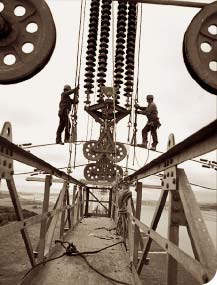Milestones:Ames Hydroelectric Generating Plant, 1891 and Milestones:First 735 kV AC Transmission System, 1965: Difference between pages
No edit summary |
No edit summary |
||
| Line 1: | Line 1: | ||
== | == First 735 kV AC Transmission System, 1965 == | ||
[[Image:First 735 kV AC transmission system.jpg|thumb|right]] | |||
[[IEEE Quebec Section History|IEEE Quebec Section]], November 2005 | |||
''' | ''Hydro-Quebec's 735,000 volt electric power transmission system was the first in the world to be designed, built and operated at an alternating-current voltage above 700 kV. This development extended the limits of long-distance transmission of electrical energy. On 29 November 1965 the first 735 kV line was inaugurated. Power was transmitted from the Manicouagan-Outardes hydro-electric generating complex to Montreal, a distance of 600 km.'' | ||
'''The plaque can be viewed at the headquarters of Hydro-Quebec 75 Boulevard René-Lévesque Ouest, Montréal, QC; and at the Manicouagan 2 Hydroelectric Generating station, on the south end of the Manicouagan Reservoir on highway 389 - 50.643474, -68.728927. ''' | |||
The large undertaking of building a 735 kV line was tackled by Jean-Jacques Archembault and the Quebec Hydro. In recognition of this great feat, the IEEE awarded Archembault the 1972 IEEE Habirshaw Award for pioneering the line. The line transported electrical power from the hydraulic centers of the Manicouagan River, in the North East of Quebec, to the load centers in the south of Quebec. It had important economic ramifications as well. the lines allowed the transmission of power from remote hydroelectric plants to load centers at a relatively low cost, thereby giving customers some of the lowest rates in the world. Due to the vast amount of materials required, including but not limited to insulators, spacers-dampers, and towers, it had an impact on national and international manufacturers. | |||
== Map == | == Map == | ||
{{#display_map: | {{#display_map:45.508095, -73.562355~ ~ ~ ~ ~Quebec, Canada|height=250|zoom=10|static=yes|center=45.508095, -73.562355}} | ||
[[Category:Energy| | [[Category:Energy|Transmission]] [[Category:Hydroelectric power generation|Transmission]] | ||
[[Category: | |||
Revision as of 18:49, 6 January 2015
First 735 kV AC Transmission System, 1965
IEEE Quebec Section, November 2005
Hydro-Quebec's 735,000 volt electric power transmission system was the first in the world to be designed, built and operated at an alternating-current voltage above 700 kV. This development extended the limits of long-distance transmission of electrical energy. On 29 November 1965 the first 735 kV line was inaugurated. Power was transmitted from the Manicouagan-Outardes hydro-electric generating complex to Montreal, a distance of 600 km.
The plaque can be viewed at the headquarters of Hydro-Quebec 75 Boulevard René-Lévesque Ouest, Montréal, QC; and at the Manicouagan 2 Hydroelectric Generating station, on the south end of the Manicouagan Reservoir on highway 389 - 50.643474, -68.728927.
The large undertaking of building a 735 kV line was tackled by Jean-Jacques Archembault and the Quebec Hydro. In recognition of this great feat, the IEEE awarded Archembault the 1972 IEEE Habirshaw Award for pioneering the line. The line transported electrical power from the hydraulic centers of the Manicouagan River, in the North East of Quebec, to the load centers in the south of Quebec. It had important economic ramifications as well. the lines allowed the transmission of power from remote hydroelectric plants to load centers at a relatively low cost, thereby giving customers some of the lowest rates in the world. Due to the vast amount of materials required, including but not limited to insulators, spacers-dampers, and towers, it had an impact on national and international manufacturers.
